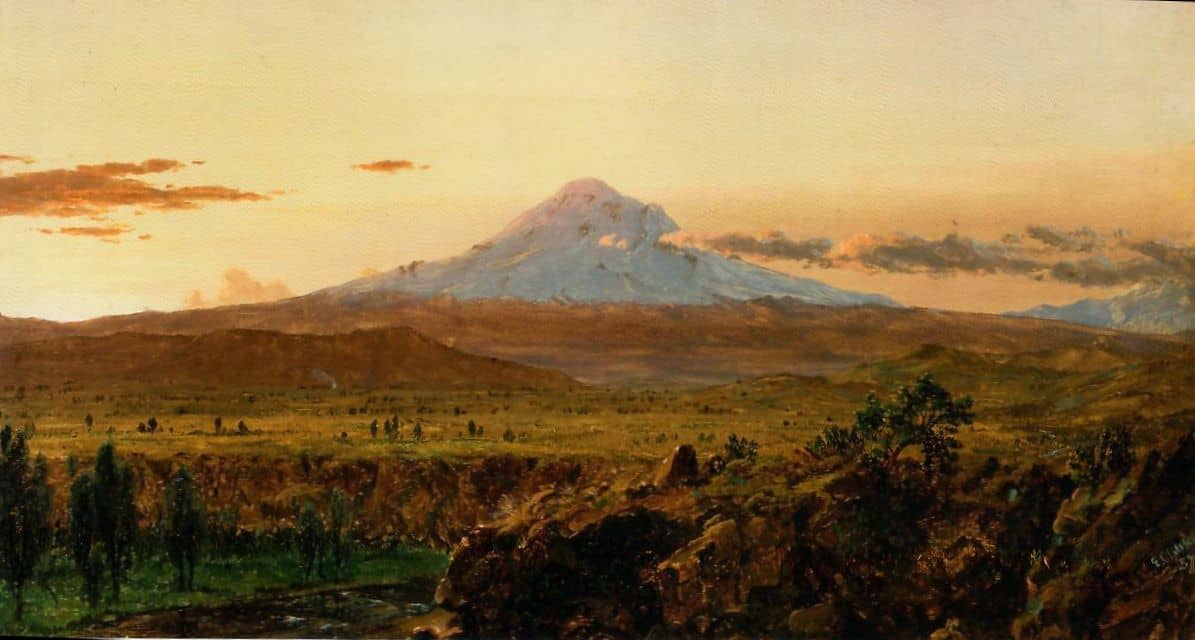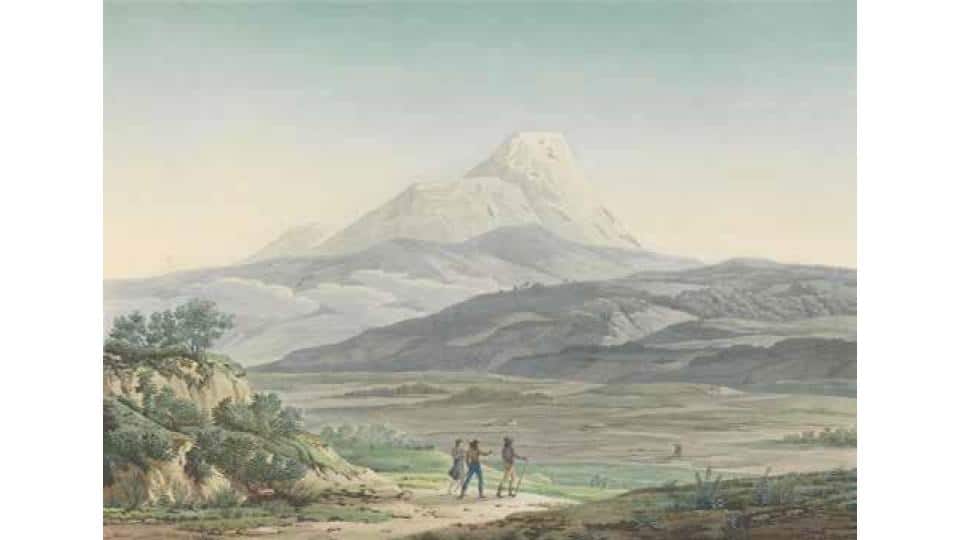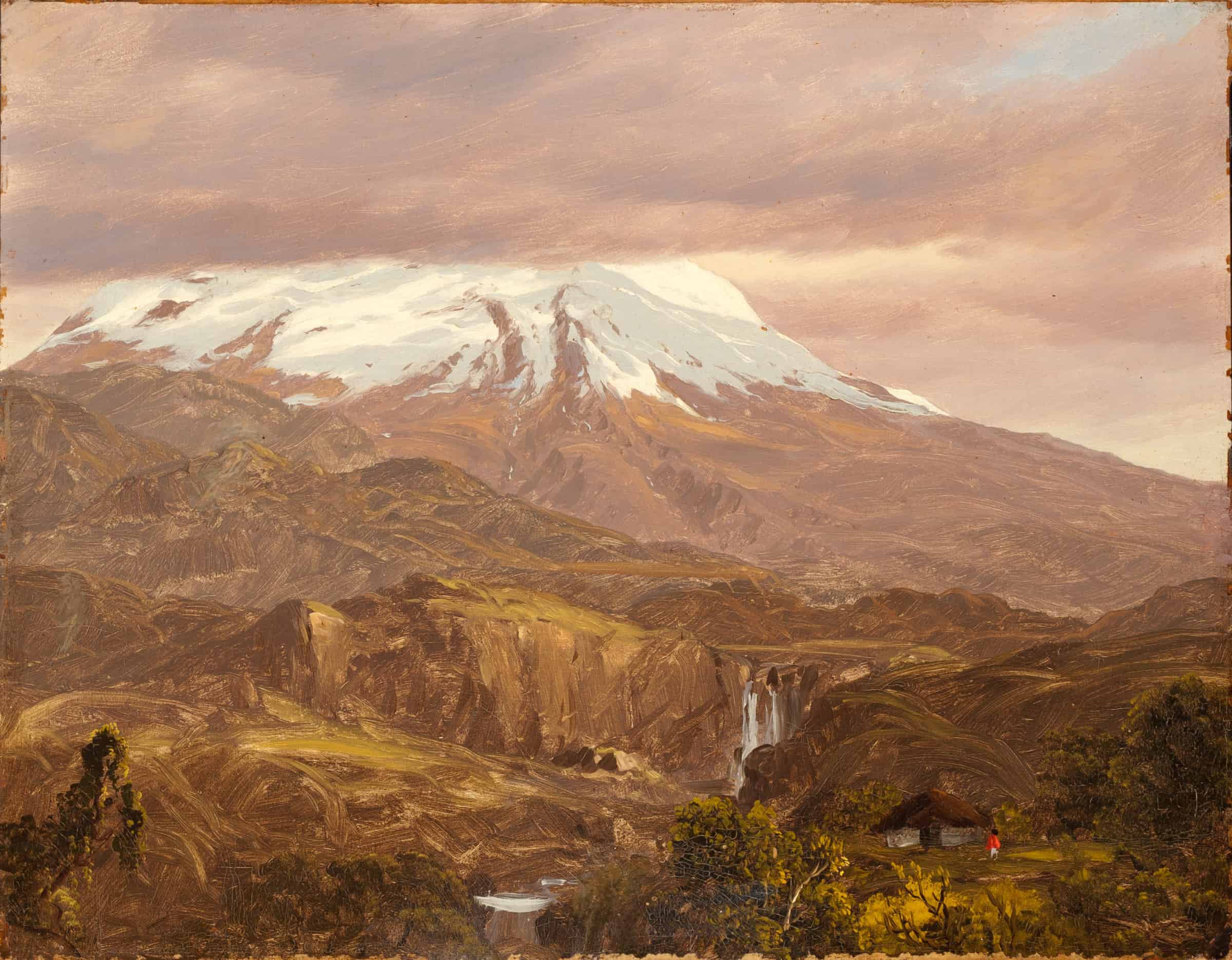“HUMBOLDT AND CHURCH”
BY ANDREA WULF”
The last days of April 1859 saw long lines of people snaking around the block of Manhattan’s Tenth Street. Many had waited for hours to pay the 25 cent entrance fee to the new Studio Building to see a painting called The Heart of the Andes by the young American artist Frederic Edwin Church. The crowds were so large that several policemen were dispatched to keep order on the street. Inside, Church had displayed his painting dramatically in a huge frame surrounded by drapes in a dark room with only the canvas illuminated. Visitors were asked to bring opera glasses so that they could see the intricate details of the enormous painting.
Five and a half feet by ten, it depicted the Andes in all their glory. The river rapids in the center of the painting were so realistic that people could almost feel the spray of the water. Trees, leaves, and flowers were all rendered so accurately that botanists were able to identify them precisely, and the snow-capped mountains stood majestically in the background. Mark Twain told his brother that the painting “will find your brain gasping,” while the 76-year-old writer Washington Irving, who had made the thirty-mile journey from his house in upstate New York to see the spectacle, pronounced it “Glorious — magnificent — such grandeur of general effect with such minuteness of detail.”
Two weeks after the opening day, Church wrote to his friend, the travel writer Bayard Taylor, explaining that he planned to send the painting to Berlin so that the celebrated Alexander von Humboldt could see the “scenery which delighted his eyes sixty years ago” — for it was Humboldt who had inspired Church to travel to South America and to paint the magnificent landscape.
Who was this man who had motivated Church? Alexander von Humboldt was born in 1769 in Berlin, the second son of a wealthy Prussian family. Just before his thirtieth birthday, he left his life of privilege and went on a five-year exploration of Latin America. It was a voyage that shaped his life and thinking, making made him legendary across the world. He was brazenly adventurous and pushed his body to the limits. He paddled along the Orinoco River deep in the rainforest in Venezuela, risked his life experimenting with electric eels that could discharge shocks of 600 volts, and climbed some of the highest volcanoes in the Andes. Later, at the age of sixty, he traveled more than 10,000 miles by coach and horse to the remotest corners of Russia to collect the observations he needed to complete his global investigation of nature.

After his return to Europe in 1804, Humboldt lived in Paris and Berlin, where he established himself as the center of scientific inquiry. Believing that knowledge had to be exchanged and made available for everybody, he experimented, gave lectures, and wrote dozens of books — many of which were translated and became international bestsellers. His books were read and admired by politicians and revolutionaries, such as Thomas Jefferson and Simón Bolívar, as well as by poets and writers, including Johann Wolfgang von Goethe, William Wordsworth, and Henry David Thoreau. Charles Darwin said that he would have never boarded the HMS Beagle without having read Humboldt, while Ralph Waldo Emerson called him “one of those wonders of the world.” Humboldt was the most famous scientist of his age.
It was during his expedition in Latin America that Humboldt came up with the revolutionary idea that the natural world was a web of life — a unified whole wherein everything was correlated. Humboldt’s nature was “a natural whole animated and moved by inward forces.” He talked of connections and unity, using terms such as “the picture” or “one glance” when writing of nature.
Humboldt was obsessed with measurements but also insisted that feelings and imagination were equally important. Nature, he explained, had to be described with scientific accuracy but “without being deprived thereby of the vivifying breath of imagination.” The senses and the intellect were connected, and knowledge did not “chill the feelings” — quite the opposite; scientific discoveries and observations only added to the grandeur of nature. Humboldt talked of the connection between knowledge and artistic feeling. No scientist had looked at nature like him before.
Humboldt insisted that traveling provided the knowledge that was needed to understand the natural world. He urged scientists to leave their desks and books in order to explore. They had to look at flora, fauna, rock strata, and climates globally — otherwise they would be like those geologists who constructed the entire world “according to the shape of the nearest hills surrounding them,” he wrote in his Essay on the Geography of Plants (1807). His call to action for artists was similar: “It would be an enterprise worthy of a great artist to study the aspect and character of all these vegetable groups, not merely in hothouses,” Humboldt declared in his book Views of Nature (1849), “but in their native grandeur in the tropical zone.”
More than any other painter, Church answered this appeal. Such was his admiration (his library at the house at Olana still holds many of Humboldt’s books) that he retraced his hero’s footsteps. Whereas other American artists embarked on the Grand Tour through Europe, Church traveled to South America. He first went in 1853 for almost seven months and then again four years later, for a little longer than two months — “to refresh my memory with Tropical scenery,” as he wrote to a friend before his departure in 1857. In addition to Humboldt’s own descriptions, Church most certainly used his copy of Heinrich Klencke’s early biography of Humboldt (1852) to work out his route through Colombia, Ecuador, and later Mexico — from a trip up the Magdalena River to Honda and Bogotá, and then across the Andes to Quito and Guayaquil. Church saw the same waterfalls and landscapes and climbed the same volcanoes (though never as high as the Prussian explorer). He even sought out one hacienda near Quito where Humboldt had stayed half a century previously and where Church commissioned the local painter Rafael Salas to make a copy of a Humboldt portrait (which he later displayed in his studio in New York and in the sitting room at his home at Olana).
Church also sketched Chimborazo, a volcano some 100 miles south of Quito that had been essential to Humboldt’s ideas. The explorer had climbed Chimborazo in June 1802, when it was believed to be the highest mountain in the world. As Humboldt had stood at the top of the world, his vision of nature clarified. He had realized, for example, that the journey from Quito and then up Chimborazo was like a botanical journey from the Equator to the poles. Where other scientists had viewed plants through the narrow lens of classification, he saw vegetation zones (stacked one on top of the other). In the valleys, he had seen palms and humid bamboo forests; further up, he had found conifers and oaks similar to those in Europe; and even higher, there were alpine plants like those he had collected in Switzerland and lichen that reminded him of specimens from Lapland. Here was nature as a global force with corresponding climate zones across continents. Church was deeply influenced by Humboldt’s descriptions. This, for example, is what Church wrote at the spectacular Tequendama Falls: “At the top of the fall you are in what is the cold country with trees and plants and fruits of temperate climates; at the bottom grow palms, oranges etc.” Church saw South America through the lens of Humboldt’s writing and then translated it into his paintings — The Heart of the Andes showed everything from the lush tropical species in the valley and the temperate zone higher up to the snow-covered peaks of the mountains.

Like Humboldt, Church was at first almost overwhelmed by what he saw: the plants, he wrote to his mother shortly after his arrival in Colombia, “would be the making of a florist,” some blossoms were “magnificent” and other plants so large that they were of “monstrous size.” Even the flowers on the roadside “would have enchanted a Botanist.” The birds sang “sweet songs” and had “beautiful plumage,” while some of the mountains rose “in perpendicular Masses like Cathedrals.” Church delighted in what he called in his diary “the great wonders of Nature.” Also like Humboldt, he fretted over his luggage. Humboldt was forever concerned about his delicate scientific instruments (he traveled with forty-two instruments that were all individually packed into protective velvet-lined boxes), while Church was worried about his portfolios, paints, and brushes. Without being able to sketch, Church anxiously waited for eight days in the small river port of Honda, about 100 miles northwest of Bogotá, for his bags. When he finally was able to recover his luggage, he wrote in his diary that his “spirits were much raised.”

Church returned to the United States with sketches of the majestic volcanoes Cotopaxi, Chimborazo, Cayambe, and Pichincha, as well as with several dozen botanical drawings. During the 1850s and sixties, he painted several stunning South American scenes. His most famous painting, though, was The Heart of the Andes, which he began after his second South American trip. More than anywhere else, Church combined beauty with the most meticulous geological, botanical, and scientific detail — this was Humboldt’s concept of interconnectedness writ large on canvas. Even in its enormous size, The Heart of the Andes followed Humboldt’s ideas, for in his book Cosmos, he had written about “the improvement in landscape painting on a scale of large dimensions.” The painting transported the viewer into the wilderness of South America. Church was, the New York Times declared, the “artistic Humboldt of the new world.”

Cosmos, which made Humboldt internationally famous, was the book that influenced Church most. When the first volume was published in 1845, it became an instant bestseller and was soon translated into a dozen languages. With Cosmos, Humboldt took his readers on an incredible journey from distant nebulae to the core of earth, from geography to poetry, from the migration of the human races to the magical beauty of the aurora borealis. At a time when scientists began to crawl into their narrowing disciplines, Humboldt wrote a book that did exactly the opposite — he brought everything together. It was a description of nature pulsating with life — a “wonderful web of organic life,” as he called it.
Two years later, after Humboldt completed the second volume, there were “real battles” for copies, his German publisher wrote. Booksellers were so desperate that bribes were offered and book parcels intercepted and stolen. It was also the book that made Humboldt a household name in America. Walt Whitman wrote his poetry collection Leaves of Grass with a copy of Cosmos on his desk; Edgar Allan Poe dedicated his last major work, the 130-page prose poem Eureka (1848), to Humboldt; Ralph Waldo Emerson devoured Cosmos; and Henry David Thoreau completely rewrote Walden after reading it. “In my work, the word ‘Cosmos’ is employed,” Humboldt explained, to express “the whole world of sense” and “the material universe.”
In the second volume of Cosmos, Humboldt took his readers on a voyage of the mind and human history from ancient civilization to modern times. He wrote about poetry and landscape painting, about Hindu philosophy and medieval perceptions of nature, as well as about voyages of discovery and Hebrew texts.
Most importantly for Church, the book was also Humboldt’s rallying call for the importance of landscape painting. In Cosmos, Church read about the “ancient and deeply-seated bond which unites natural knowledge with poetry and with artistic feeling.” Landscape painting, Humboldt wrote, linked the external and the internal world — it brought together nature, science, and imagination. It was instructive, emotional, and it “incites to fuller intercourse with nature in her freedom” and “increases the longing desire for distant voyages.”
Here, in the second volume of Cosmos, Church received instructions that seemed tailored entirely to him. Not only was he a successful landscape painter, but he was fascinated by the sciences and adored traveling (he also owned hundreds of science books, travel accounts, and atlases). In Cosmos, Humboldt called for “highly-gifted young artists” to travel to the tropics to seize “the living image of the manifold beauty and grandeur of nature in the humid mountain valleys of the tropical world.”
Since his time under the tutelage of Thomas Cole, Church had spent much of his summers and autumns painting in the Catskills and Maine, but the gauntlet that Humboldt threw down was much more exciting — it combined adventure, travel, art, science, and the most spectacular landscapes. Colored sketches should be “taken on the spot,” Humboldt advised — sketches of trees, of branches clothed in leaves and blossoms, of fallen tree trunks overgrown with orchids, of rocks and river banks, of mountain peaks and forest floors — “all drawn or painted directly from nature.”
Humboldt himself often used visual aids to illustrate scientific data — from his famous Naturgemälde, which showed a cross section of Chimborazo with all the plants he had found according to their altitude, to his invention of isotherms, the lines we see on weather maps today and which connect different geographical points around the globe that are experiencing the same temperatures. He had also published stunning engravings of the New World in his Vues des Cordillères, et monumens des peuples indigènes de l’Amérique (1810–13) — a lavish large folio edition of sixty-nine gorgeous engravings of landscapes, volcanoes, Aztec manuscripts, and Mexican calendars, among many others. “Nature and art are closely united in my work,” Humboldt had written in a note when he dispatched the first installment of the book to Goethe on 3 January, 1810. The eye, Humboldt wrote in Cosmos, was the organ of Weltanschauung, through which we observe the world but also through which we interpret, define, and understand it.
Humboldt was so keen on landscape painting that he supported artists whenever he could. He organized stipends for them to travel, wrote letters of recommendations, and devised routes. He also wrote detailed instructions, advising one German artist to paint the tropical forest from the vantage point of a mountain so that he could perceive all different plants from there. An artist had to communicate scientific knowledge, feelings, and the truth of nature. Humboldt corresponded with such painters as Swiss-born Karl Bodmer and American George Catlin, who both depicted Native Americans in the West. He also recommended German artist Ferdinand Bellermann to join an expedition to Venezuela and in the 1830s inspired Johann Moritz Rugendas to paint the life and nature of Latin America (Rugendas spent more than a decade there). More than any other painter, though, it was Church who incorporated Humboldt’s vision of nature on his canvas.
Clearly proud by the success of the The Heart of the Andes, Church longed for Humboldt to see the painting. Bayard Taylor, who had met Humboldt in Berlin, offered to introduce Church’s agent to the ageing scientist. “The Heart of the Andes,” Bayard Taylor wrote to Humboldt, was a “masterpiece” and Church “was several years ago moved — by your descriptions of the tropical Nature in Kosmos — to make a sketching expedition to Quito.” Church intended to send the painting to Berlin, Taylor added, so that “you may see it and perhaps rejoice in gazing once more on the beautiful land you traveled in 60 years ago.”
Humboldt had last seen South America as a young man but he always talked about his expedition there as the most important years of his life. He was of a “tropical nature,” he said often. Seeing Church’s stunning depiction of the Andes would have certainly delighted Humboldt. But the celebrated scientist never received Taylor’s letter, nor did he see The Heart of the Andes because he had died in Berlin ten days earlier at the age of eighty-nine. When the steamer that carried the news of Humboldt’s death reached the United States, Church told Taylor that it “touched me as if I had lost a friend.”
The Heart of the Andes is a testimony to Church’s admiration for Humboldt. Church was, as one critic wrote in London a few years later, “the very painter Humboldt so longs for in his writings.”
Andrea Wulf’s most recent book is about Alexander von Humboldt and his influence on scientists, artists, poets, and writers. The Invention of Nature. Alexander von Humboldt’s New World is a New York Times Bestseller and was published in 2015 to great acclaim, most notably winning the Costa Biography Award in the UK and being shortlisted for the Andrew Carnegie Medal 2016.

